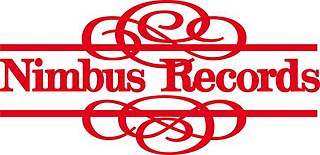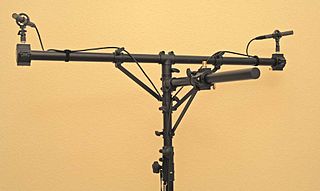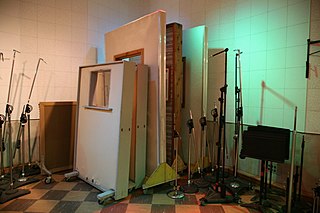Related Research Articles

An effects unit or effects pedal is an electronic device that alters the sound of a musical instrument or other audio source through audio signal processing.
Dynamic range is the ratio between the largest and smallest values that a certain quantity can assume. It is often used in the context of signals, like sound and light. It is measured either as a ratio or as a base-10 (decibel) or base-2 logarithmic value of the difference between the smallest and largest signal values.
A timecode is a sequence of numeric codes generated at regular intervals by a timing synchronization system. Timecode is used in video production, show control and other applications which require temporal coordination or logging of recording or actions.
A music sequencer is a device or application software that can record, edit, or play back music, by handling note and performance information in several forms, typically CV/Gate, MIDI, or Open Sound Control (OSC), and possibly audio and automation data for DAWs and plug-ins.

Audio mixing is the process by which multiple sounds are combined into one or more channels. In the process, a source's volume level, frequency content, dynamics, and panoramic position are manipulated or enhanced. This practical, aesthetic, or otherwise creative treatment is done in order to produce a finished version that is appealing to listeners.

A production sound mixer, location sound recordist, location sound engineer, or simply sound mixer is the member of a film crew or television crew responsible for recording all sound recording on set during the filmmaking or television production using professional audio equipment, for later inclusion in the finished product, or for reference to be used by the sound designer, sound effects editors, or foley artists. This requires choice and deployment of microphones, choice of recording media, and mixing of audio signals in real time.

A recording studio is a specialized facility for sound recording, mixing, and audio production of instrumental or vocal musical performances, spoken words, and other sounds. They range in size from a small in-home project studio large enough to record a single singer-guitarist, to a large building with space for a full orchestra of 100 or more musicians. Ideally both the recording and monitoring spaces are specially designed by an acoustician or audio engineer to achieve optimum acoustic properties.

Surround sound is a technique for enriching the fidelity and depth of sound reproduction by using multiple audio channels from speakers that surround the listener. Its first application was in movie theaters. Prior to surround sound, theater sound systems commonly had three "screen channels" of sound that played from three loudspeakers located in front of the audience. Surround sound adds one or more channels from loudspeakers to the side or behind the listener that are able to create the sensation of sound coming from any horizontal direction around the listener.

Cubase is a digital audio workstation (DAW) developed by Steinberg for music and MIDI recording, arranging and editing. The first version, which was originally only a MIDI sequencer and ran on the Atari ST computer, was released in 1989. Cut-down versions of Cubase are included with almost all Yamaha audio and MIDI hardware, as well as hardware from other manufacturers. These versions can be upgraded to a more advanced version at a discount.

Nimbus Records is a British record company based at Wyastone Leys, Ganarew, Herefordshire. They specialise in classical music recordings and were the first company in the UK to produce compact discs.

Sound recording and reproduction is an electrical, mechanical, electronic, or digital inscription and re-creation of sound waves, such as spoken voice, singing, instrumental music, or sound effects. The two main classes of sound recording technology are analog recording and digital recording.

The Decca Tree is a spaced microphone array most commonly used for orchestral recording. It was originally developed as a sort of stereo A–B recording method adding a center fill. The technique was developed in the early 1950s and first commercially used in 1954 by Arthur Haddy, Roy Wallace, and later refined by engineer Kenneth Ernest Wilkinson and his team at Decca Records, to provide a strong stereo image.

Roger Powell is a musician, programmer, and magazine columnist best known for his membership with the rock band Utopia.
A DJ mix or DJ mixset is a sequence of musical tracks typically mixed together to appear as one continuous track. DJ mixes are usually performed using a DJ mixer and multiple sounds sources, such as turntables, CD players, digital audio players or computer sound cards, sometimes with the addition of samplers and effects units, although it is possible to create one using sound editing software.
There exist a number of well-developed microphone techniques used for recording musical, film, or voice sources. Choice of technique depends on a number of factors, including:

In music recording, mix automation allows the console to remember the audio engineer's adjustment of faders during the post-production editing process. A timecode is necessary for the synchronization of automation. Modern mixing consoles and digital audio workstations use comprehensive mix automation.

In sound recording and reproduction, audio mixing is the process of optimizing and combining multitrack recordings into a final mono, stereo or surround sound product. In the process of combining the separate tracks, their relative levels are adjusted and balanced and various processes such as equalization and compression are commonly applied to individual tracks, groups of tracks, and the overall mix. In stereo and surround sound mixing, the placement of the tracks within the stereo field are adjusted and balanced. Audio mixing techniques and approaches vary widely and have a significant influence on the final product.

Spill is the occurrence in sound recording and live sound mixing whereby sound is picked up by a microphone from a source other than that which is intended. Spill is usually seen as a problem, and various steps are taken to avoid it or reduce it. In some styles of music, such as orchestral music, jazz, and blues, it is more likely to be accepted or even seen as desirable.

Overhead microphones are those used in sound recording and live sound reproduction to pick up ambient sounds, transients and the overall blend of instruments. They are used in drum recording to achieve a stereo image of the full drum kit, as well as orchestral recording to create a balanced stereo recording of full orchestras.

To cue audio is to determine the desired initial playback point in a piece of recorded music. It is a technique often used in radio broadcasting and DJing. One dictionary definition is to "Set a piece of audio or video equipment in readiness to play ."
References
- ↑ Huber, David. "David Miles Huber".
- 1 2 Huber, David. "Colabs" . Retrieved 5 April 2013.
- ↑ Huber, David. "Colabs 2008" . Retrieved 5 April 2013.
- ↑ Huber, David. "Relaxation & Meditation With Music & Nature" . Retrieved 5 April 2013.
- 1 2 Huber, David. "Between the Sea & The Sky" . Retrieved 5 April 2013.
- ↑ Huber, David. "55th Annual Grammy Awards" . Retrieved 23 April 2013.
- ↑ Huber, David Miles (1987). Audio production techniques for video. Boston.[Mass.]: Focal Pr. ISBN 978-0240801483.
- ↑ Huber, David Miles (1988). Microphone manual : design and application (1st ed.). Indianapolis, Ind., USA: H.W. Sams. ISBN 978-0672225987.
- ↑ Huber, David Miles (1992). Random access audio. Carmel, Ind., USA: SAMS Pub. ISBN 978-0672300868.
- ↑ Huber, David Miles (1995). Hard disk recording for musicians. New York: Amsco Publications. ISBN 978-0825614330.
- ↑ Huber, David Miles (1998). Professional microphone techniques (2. printing. ed.). Emeryville, CA: MixBooks. ISBN 978-0872886858.
- ↑ Runstein, David Miles Huber, Robert E. (2010). Modern recording techniques (7th ed.). Amsterdam: Focal Press/Elsevier. ISBN 978-0240810690.
- ↑ Huber, David Miles (2007). The MIDI manual : a practical guide to MIDI in the project studio (3rd ed.). Amsterdam: Elsevier/Focal Press. ISBN 978-0240807980.